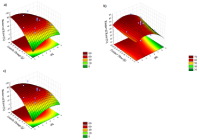Effect of turbidity on ultraviolet disinfection of domestic wastewater for agricultural reuse
Abstract
Water treatment and reuse are fundamental because of the increasing demand for freshwater, especially in agriculture. Accordingly, this study evaluated the effects of turbidity of wastewater processed at the Effluent Treatment Station (ETE) of the UFSCar/Araras and of UV dose on microbial inactivation. The ETE treats up to 2000 L of wastewater daily from toilets and a university restaurant and has five components (grease box, septic tank, microalgae tank, upflow anaerobic filter, and wetlands). Pretreated effluents were used in the experiments, and sampling sites consisted of inspection boxes located after the wetlands. Sample collection, inspection, preservation, and analyses were performed according to standard methods. Sample turbidity was adjusted to 5, 50, 100, 200, and 300 nephelometric turbidity units (NTU), and UV doses of 7.2–28.8 mWs cm-2 were used. A 5 x 5 factorial design (five turbidity levels and five radiation doses) was used, totaling 25 treatments. Each treatment was performed in triplicate. The data were submitted to analysis of variance and Tukey’s test. The results showed that the increase in turbidity significantly decreased disinfection efficiency in samples with turbidity levels higher than 50 NTU. The microbial inactivation coefficients obtained here can be extrapolated to disinfection of wastewater with turbidity up to 300 NTU to eliminate thermotolerant coliforms. The UV sterilizer is feasible for wastewater treatment and its reuse in agriculture.
Keywords: domestic effluent, sustainability, ultraviolet radiation, water reuse.
Authors maintain the copyrights for their work. However, they grant rights of first publication to Ambiente e Agua - An Interdisciplinary Journal of Applied Science. In compensation, the journal can transfer the copyrights, allowing non-commercial use of the article including the right of sending the article to other data bases or publication media. The journal uses the CC BY 4.0 license"






